| |  |  | | Lake Pontchartrain Atlas: | |  | | |  | | |  | | |  | | |  | | |  | | |  | | |  | | |  | | |  | | Environmental Issues |  | |  | | |  | | |  | | |  |  | |  | |  | | |  |  |  | | | |  | Environmental Issues - Water Quality Contributor: Turner 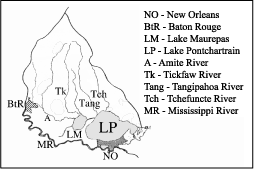 | | Figure 89: The major geographical features of Lake Pontchartrain Watershed. | Estuarine plant and animal growth and accumulation are understood to be strongly influenced by nutrient concentration or loading, especially from dissolved inorganic nitrogen, but also by inorganic phosphorus and silicate. The increased loading of nutrients to coastal systems is a continuing and widespread problem because of the often multiple undesirable consequences, such as: noxious algal blooms (Dortch et al., 1996), loss of seagrass habitat (Poirrier et al., 1999), low bottom-water oxygen, and fisheries losses. Understanding nutrient loading amounts and changes is, in this context, both a basic and applied issue for coastal scientists and managers. The 1997 opening of the Bonnet Carré Floodway on the southwest shore of Lake Pontchartrain alleviated the flood threats to New Orleans, but also created a massive algal bloom (see Satellite Imagery of the 1997 Bonnet Carré Spillway Opening ) that prompted health advisories by the LDHH. Development on the north shore of Lake Pontchartrain and control of urban run-off are additional management issues related to water quality, not only in Lake Pontchartrain, but also in the entire watershed (Figure 89). Experimental and field observations demonstrated that nitrogen exerts an influence on the phytoplankton community in Lake Pontchartrain. Although water clarity influences phytoplankton biomass, it is approximately proportional to the net increase in nitrogen loading. Nitrogen loading into the Lake may come from rivers, atmospheric loading, urban runoff, leakage through the Bonnet Carré Spillway when the River is at high water levels, or from the diversion of Mississippi River water through the spillway into Lake Pontchartrain. Although intrusion of water from the Mississippi River is an intermittent factor, it appears to cause dramatic changes in the Lake's ecology. 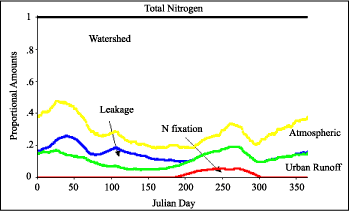 | | Figure 90: Seasonal distribution of all sources of nitrogen into Lake Pontchartrain in 365 julian days, by proportion. | 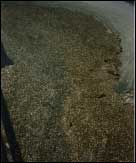 | | Figure 91: Fish kill in Bayou St. John, June 1995, shadow of person seen on left for scale. Photograph courtesy of Neil Armingeon, LPBF. | A nitrogen loading budget was established for Lake Pontchartrain. New and previously published stream flow and water quality measurements were used to establish the annual and seasonal variations in loading rates from the various sources. The relatively stable annual loadings come from: the watershed (7.8 million kg N), pumped urban runoff from New Orleans (1.0 million kg N), atmosphere (1.25 million kg N), and leakage through the Bonnet Carré flood control structure (0.5 to 0.9 million kg N) (Figure 90). Relatively minor additional amounts come from nitrogen fixation. Occasional openings of the Bonnet Carré Spillway could triple the annual average loading within 1 to 2 months, and proposed smaller diversions could raise present nitrogen loadings by 50%. Management of various nitrogen loadings seems quite possible, especially given that present loadings are almost all reducible through existing approaches such as sewerage treatment. The majority of nitrogen loading to Lake Pontchartrain in an "average" year comes from riverine discharge on the north shore of Lake Pontchartrain, and the smallest amount derives from nitrogen fixation (Table 25). The Bonnet Carré Floodway opening delivers many times more nitrogen in a few months than the total of the nitrogen loading in an average year with additional input as a result of significant leakage during normal high water stages. All of the nitrogen in the diverted water passes through the spillway and into Lake Pontchartrain (Turner, 1998). A surprisingly large amount comes from atmospheric loadings, which can be significant in many estuaries. The original landscape, in the absence of agriculture and urbanization would have had an annual nitrogen loading rate of about 90 million kg N (Turner et al., 1999). Thus there appears to have been a 10 fold increase in loading in the Lake Pontchartrain watershed as a result of anthropogenic influence. The nitrogen loading from the Lake Pontchartrain Basin is about 2 to 3 times higher than anticipated on the basis of the Basin population density, which suggests that sewerage treatment in the watershed is minimal, as evidenced by the occasional high coliform densities observed in streams. These densities are often high enough that the state posts various water-quality warnings to recreational boaters and swimmers. Figures 91 - 93 show examples of the effects of increased nitrogen loading in the LPB. 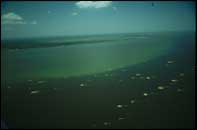 | | 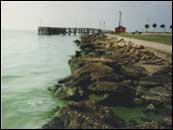 | | Figure 92: Phytoplankton bloom in 1997, North-west of causeway. Photography by R.E.Turner. | | Figure 93: Cyanobacteria coating rocks on Breakwater Drive, June 1995. Photograph courtesy of Neil Armingeon, LPBF. | Management of nitrogen loading into the watershed is a feasible proposition even with the likely further urban expansion on the northern shore of the Lake. The consequences of future nitrogen loadings resulting from population growth on the north shore of Lake Pontchartrain can be compensated for by rather rudimentary sewerage treatment of existing non-point sources, from treatment or diversion of pumped urban runoff, and by sealing the leakage of water passing through the Bonnet Carré Spillway. Alternatively, the positive benefits of these actions might be overwhelmed by increasing nutrient flows through a small diversion, as well as from more frequent openings of the Bonnet Carré Spillway that may result from global climate change effects. | Table 25: Population Equivalents of the Nitrogen Loading to Lake Pontchartrain.* | | Loading Source | Population Equivalents (at 2.95 Kg N per capita) | | 1. Pumped urban runoff | 345,890 | | 2. Leakage from Bonnet Carré | 167,808 | | 3. Atmospheric (Lakes Pontchartrain and Maurepas) | 489,505 | | 4. Nitrogen fixation - average rainfall year | 54,795 | | 5. Watershed (Riverine Discharge) | 2,660,959 | | 6. Bonnet Carré opening in 1997 | 8,390,411 | 7. A 10,000 cfs diversion operated for 3 months
(assuming no net nitrogen removal) | 1,622,760 | | Estimated 1990 Population of watershed: 820,235 (exclusive of New Orleans Metropolitan area) * The New Orleans Metropolitan area is not included, except for pumped urban runoff, because its sewerage is treated and disposed outside of the Lake Pontchartrain watershed. | |
« Previous | Next » |

